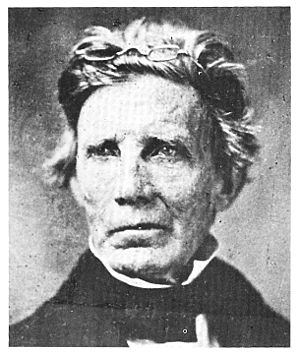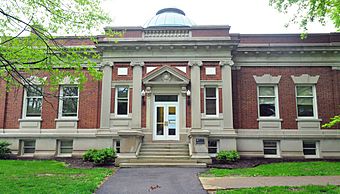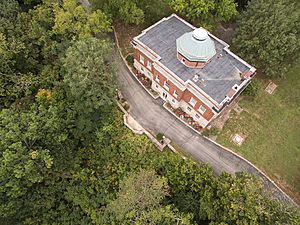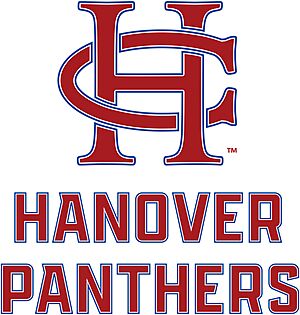Hanover College facts for kids
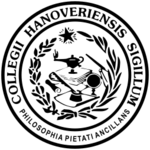
Seal: Philosophia pietati ancillans (Latin)
"Knowledge in service of piety" |
|
|
Former name
|
Hanover Academy (1827–1833) |
|---|---|
| Type | Private college |
| Established | January 1, 1827 |
|
Religious affiliation
|
Presbyterian Church (USA) |
| Endowment | $163.7 million (2024) |
| President | Lake Lambert III |
|
Academic staff
|
89 Full-time & 7 part-time |
| Undergraduates | 1,070 |
| Location |
,
U.S.
38°42′44″N 85°27′39″W / 38.71222°N 85.46083°W |
| Campus | Rural 650 acres (260 ha) |
| Colors | Red and blue |
| Nickname | Panthers |
|
Sporting affiliations
|
NCAA Division III, Heartland Collegiate Athletic Conference |
| Mascot | Panther |
 |
|
Hanover College is a private college in Hanover, Indiana. It is connected with the Presbyterian Church (USA). Reverend John Finley Crowe started the college in 1827. It is the oldest private college in Indiana.
Hanover's sports teams are called the Panthers. They play in NCAA Division III. They are part of the Heartland Collegiate Athletic Conference. People who graduated from Hanover College are called Hanoverians.
Contents
History of Hanover College
How Hanover College Started
In the early 1800s, missionaries came to Hanover. They were part of a religious movement. John Finley Crowe was the pastor of the Hanover Presbyterian Church. He opened the Hanover Academy on January 1, 1827. It was in a small log cabin near his home.
Two years later, the state of Indiana gave the academy a special permission document called a charter. On November 9, 1829, the academy's leaders agreed to let a Presbyterian Church group adopt the school. This happened if a special department for religious studies was added.
A two-story brick building was built for both the academy and the new Indiana Seminary. Indiana gave the academy a new charter. This officially created Hanover College on January 1, 1833. The college's leaders are independent from church control. However, they follow the standards for Presbyterian colleges. This connection continues today.
In the 1830s, the College Edifice was the main building. It is now the Hanover Presbyterian Church. The campus was about 3 acres. In 1834, 119 students attended Hanover Preparatory School. This was the old Hanover Academy. Also, 101 students attended Hanover College. This was fast growth from only six students seven years earlier.
In 1843, the college president and leaders agreed to move Hanover College. This was a plan from leaders in Madison, Indiana. The Hanover charter was ended. Madison University was started five miles east. But John Finley Crowe bought the college property. He started the Hanover Classical and Mathematical School.
Four months after Madison University began, its president left. Students started returning to Crowe's school. By May 1844, all of Madison's students and teachers had moved back. Hanover College was officially restarted. Indiana's government gave the college a new charter on Christmas Day. Crowe taught at the college for over 30 years. He is known as "twice the founder of Hanover College."
In 1849, the college leaders bought a 200-acre farm. It was half a mile east of the campus. By the mid-1850s, Classic Hall was built. It was on a high point called the Point. College classes moved to this new spot. "Old Classic" was Hanover's most famous building for over 90 years.
During the American Civil War, Confederate troops came close to campus. This was during Morgan's Raid. Teachers and students were warned that the troops might try to burn Classic Hall.
In 1870, Presbyterian Church officials suggested merging Hanover College with Wabash College. Hanover would become a women's school. Hanover's leaders said no. They also rejected a plan in 1873 to move the college to Indianapolis. That plan would have renamed it Johnson University. In 1880, Hanover started accepting women students.
Hanover College in the 1900s
For its first 50 years, Hanover College had nine presidents. None stayed longer than nine years. Five served three years or less. After that, things became more stable. Daniel Fisher led Hanover from 1879 until 1907. This steady leadership brought new growth. Fisher oversaw the building of five new buildings. One was the Thomas A. Hendricks Library. It is now called Hendricks Hall.
It was named for Thomas Hendricks, a former U.S. vice president and Hanover graduate. Today, Hendricks Hall is used for offices. It is the oldest classroom building on campus.
Albert G. Parker Jr. became Hanover's 12th president on November 27, 1929. This was less than a month after the stock market crash. That crash started the Great Depression. The tough economic times reduced college funds. Spending had to be watched very carefully.
On December 7, 1941, the attack on Pearl Harbor happened. This brought the United States into World War II. In just two years, Hanover's student numbers dropped to 164. Only 20 of these were men. In the early morning of December 19, 1941, a huge fire destroyed most of Classic Hall. By 1946, after the war, Hanover had 679 students.
In 1947, Long College for Women was founded. It was a college for women connected to Hanover. Until the 1960s, all women who graduated from Hanover received their degree from Long. Long College operated until 1978. Then, the two colleges fully merged. Hanover officially became a co-ed school for both men and women.
Parker had planned to retire as president on September 1, 1958. But he passed away in March of that year. John E. Horner was named interim president. He ended up serving for 29 years.
Under Horner's leadership, Hanover grew a lot. Its academic programs, finances, and student numbers all improved. Soon after he arrived, he encouraged teachers to update their courses. Hanover divided its school year into two 14-week terms. Students took three classes in each. There was also a five-week Spring Term. In this term, students took one special, focused course. This system, with some changes, is still used today. Spring, or May, Term is a month where students study intensely. Many courses involve travel or unique on-campus studies.
By the mid-1960s, the campus grew to over 500 acres. Student numbers reached over 1,000. Hanover's money reserves were close to $15 million.
In the late afternoon of April 3, 1974, a powerful tornado hit the campus. It was part of the 1974 Super Outbreak of tornadoes. These storms hit 13 states and one part of Canada that day. No one was killed or seriously hurt. But 32 of the college's 33 buildings were damaged. Two were completely destroyed. Six had major damage. One destroyed building was a student dorm. Hundreds of trees were knocked down. All roads on campus were blocked. It was hard to talk to people off campus.
Government officials estimated the damage at $10 million. Some people wondered if Hanover College could survive. But the Hanover community, led by President Horner, quickly took action. The winter term ended one week early. Students were sent home. But many stayed to help teachers and staff clear the mess. The college leaders met on April 5 in an emergency meeting. They promised to rebuild and improve Hanover College. They decided to do this without any government disaster help. This continued Hanover's tradition of being financially independent.
Within a week, roads were cleared. Major services were restored. Donations came in to cover Hanover's $1 million in losses that insurance did not cover. They raised this money in three months. When Spring Term started on April 22, the college had all its students back. This was just 19 days after the tornado. An article in The Indianapolis Star called it "a private miracle." By spring 1975, new trees were planted. Hanover's recovery was complete.
When Horner retired in 1987, Hanover's money reserves were over $40 million. Russell Nichols became Hanover's 14th president on September 26, 1987. He worked to make the Hanover experience better for students. The number of full-time teachers increased from 72 to 94 over five years. This meant fewer students per teacher. It also allowed for more independent research. Six new academic subjects were added.
Students got a direct-dial phone in each dorm room. This ended years of needing a campus operator to connect calls. More importantly, money for school help was increased for new and returning students. In 1995, the $11 million Horner Health and Recreation Center opened. It was named for the former president and his wife.
Hanover College in the 2000s
In 2000, a $23 million Science Center was opened. It now holds all of the college's science departments in one building.
In May 2006, Nichols announced he would retire in 2007. His achievements included changing the courses to offer more study abroad options. He also started the Center for Business Preparation. This program connects a broad education with business skills. In 2004, Hanover received $11.4 million. This was to start the Rivers Institute. It is a center to study all parts of rivers around the world.
In the fall of 2007, Sue DeWine became Hanover's 15th president. She was previously a leader at Marietta College in Ohio. Lake Lambert took over from DeWine in 2015.
Presidents of Hanover College
- James Blythe, 1832–1836
- Duncan McAuley, March – July 1838
- Erasmus D. MacMaster, 1838–1843
- Sylvester Scovel, 1846–1849
- Thomas E. Thomas, 1849–1854
- Jonathan Edwards, 1855–1857
- James Wood, 1859–1866
- George D. Archibald, 1868–1870
- George C. Heckman, 1870–1879
- Daniel Webster Fisher, 1879–1907
- William A. Millis, 1908–1929
- Albert Parker, 1929–1958
- John Horner, 1958–1987
- Russell Nichols, 1987–2007
- Sue DeWine, 2007–2015
- Lake Lambert, 2015–present
Hanover College Campus
Hanover College is on 650 acres of land. It overlooks the Ohio River. The land has climbing paths and cliffs. It also has the only spot where you can see three bends in the Ohio River. The campus buildings are in the Georgian style. The main quad area has the Parker Auditorium. It is named for former president Albert Parker.
In the 1940s, the college did not approve plans to rebuild a fraternity house. The design was by Frank Lloyd Wright. It was not approved because it did not match the Georgian style.
Much of the campus was badly damaged by a tornado on April 3, 1974. Several buildings were destroyed. Damage to 32 of the 33 buildings was over $10 million. The campus lost hundreds of old trees.
Academics at Hanover College
Hanover College offers many liberal arts courses. These courses help students explore and grow intellectually. The college has almost 40 undergraduate majors. These include subjects like Anthropology, Computer Science, English, and Psychology. They also have newer fields like Data Science. Students can even create their own major.
Special Programs and Advanced Degrees
Hanover offers special pathways for students. These help them prepare for careers in Accounting, Education, Engineering, Health Sciences, and Law.
The college also offers some advanced professional degrees:
- Doctor of Physical Therapy (DPT): This is a fast-paced program. It combines in-person labs, practice in clinics, and online classes.
- Doctor of Occupational Therapy (OTD): This program is also fast-paced and uses a mix of learning methods. It focuses on clinical skills and research.
Student Support and Learning Tools
Hanover helps students with many academic services:
- Every student gets a faculty advisor. This person helps guide them.
- The Levett Career Center helps with career and graduate school advice.
- The Gladish Center for Teaching and Learning and Duggan Library offer tutoring. They also provide mentoring and research help.
- The Registrar's Office handles class registration and transferring credits.
Teachers and Research Opportunities
Teachers at Hanover are very involved in teaching and guiding students. They also do research. This gives students chances to join in guided studies and their own research projects.
College Rankings
Hanover College was tied for 103rd place in National Liberal Arts Colleges. This was according to U.S. News & World Report in 2025.
Student Life
There are nine national fraternities and sororities at Hanover College.
Sports at Hanover College
Hanover College teams are called the Panthers. Their mascot is a panther. They play in the National Collegiate Athletic Association's Division III. They are also part of the Heartland Collegiate Athletic Conference (HCAC).
Men's sports include baseball, basketball, cheerleading, cross country, football, golf, lacrosse, soccer, swimming, tennis, and track & field. Women's sports include basketball, cheerleading, cross country, golf, lacrosse, soccer, softball, swimming, tennis, track & field, and volleyball. Hanover added men's and women's swimming in the fall of 2018.
Notable Alumni
- John M. Bloss 1860, former president of Oregon State University
- James Graham Brown, businessman and giver of money to good causes
- John Merle Coulter 1870, botanist and professor
- Stanley Coulter 1870, dean at Purdue University
- William A. Cullop, member of the United States House of Representatives
- Chris Culver, crime novelist
- Thomas Cleland Dawson 1888, diplomat
- Brett Dietz, former football player and coach
- Bob Donewald, basketball coach
- William Donner 1887, steel industry businessman
- Denny Dorrel, football coach
- Ebenezer Dumont 1836, member of the United States House of Representatives and general in the Union Army
- Peter Dunn 2000, financial author and TV personality
- William M. Dunn, member of the United States House of Representatives
- Jonathan Edwards, first president of Washington & Jefferson College
- Harriet Elliott, educator and community leader
- William Hayden English, politician and candidate for U.S. vice president
- Walter L. Fisher, United States Secretary of the Interior
- Isaac Kwaku Fokuo Jr, consultant and founder
- Woody Harrelson, actor
- Charles Sherrod Hatfield 1904, judge
- Philip Hedrick 1964, population geneticist
- Thomas Andrews Hendricks 1841, 21st vice president of the United States and former governor of Indiana
- Eric Holcomb 1990, current governor of Indiana
- Thomas M. Honan, former Indiana Attorney General
- Peter Kassig, aid worker
- Walter LaFeber, historian
- Bertha Lewis, CEO and chief organizer of ACORN
- Colonel Leslie MacDill, early aviation pioneer
- John Miller, justice of the Indiana Supreme Court
- Oscar H. Montgomery, justice of the Indiana Supreme Court
- John Davis Paris 1833, builder of churches in Hawaii
- James Kennedy Patterson 1856, first president of University of Kentucky
- Lafe Pence 1877, member of the United States House of Representatives
- Mike Pence, 1981, 48th vice president of the United States and former governor of Indiana
- Albert G. Porter, former governor of Indiana
- John Resig, 2001, co-founder of Resignation Media, LLC
- Carol Warner Shields, author who won a Pulitzer Prize
- Micah Shrewsberry, 1999, head coach for the Notre Dame Fighting Irish men's basketball team
- Monica Sone, author of Nisei Daughter
- Reginald H. Thomson, civil engineer who designed modern Seattle
- Robert J. Tracewell, member of the United States House of Representatives
- Tony Vittorio, college baseball coach
- William Ross Wallace 1836, poet
- George F. Whitworth, missionary and founder of Whitworth College
- Harvey W. Wiley, chemist involved with the Pure Food and Drug Act
- James Wylder, writer and founder of Arcbeatle Press


